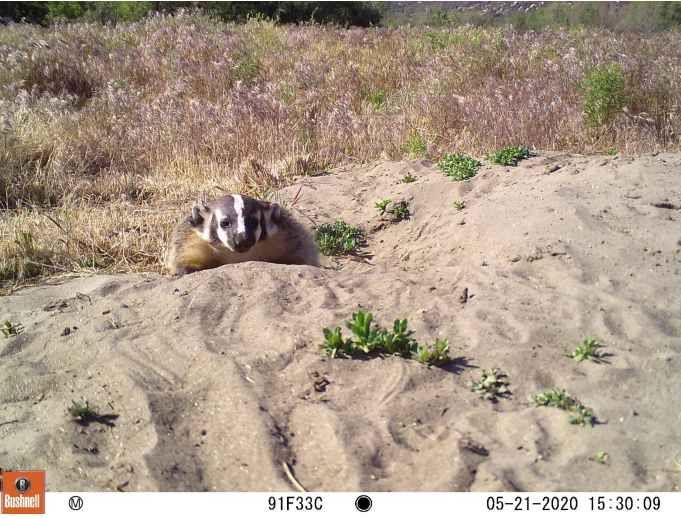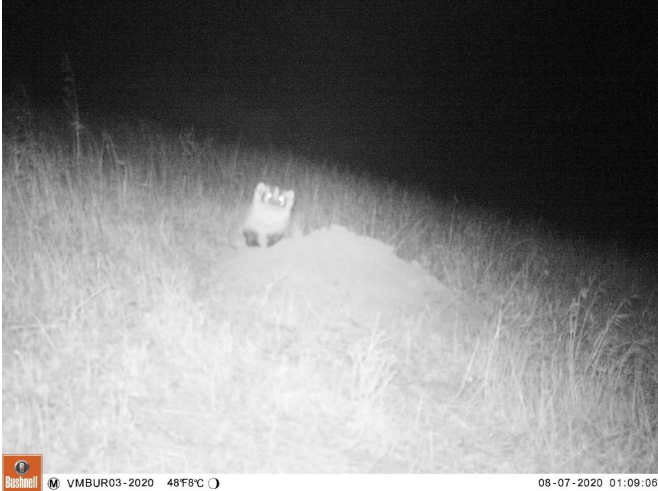Vertebrate Species completed
American Badger Research and Monitoring
Badgers have been identified by the San Diego Monitoring and Management Program Connectivity Monitoring Strategic Plan as a target species for monitoring regional-scale functional connectivity of upland and grassland habitats. However, prior to these studies there was little information on badger distribution, movement, or habitat use within San Diego County. In 2011, the California Department of Fish and Game Local Assistance Grant funded an initial study to determine if badgers still persist in the western portion of San Diego County. Canine scent surveys were conducted for American badger scat from November 14-December 14, 2011. Thirty-two sites in San Diego County and two sites in southern Riverside County were surveyed. The scent dog had positive behavioral responses to scat at 13 sites, and a badger specific DNA test verified the scat collected at twelve sites. A recommendation from the 2011 study led researchers to develop a microsatellite DNA test to identify individual animals from scat. This would allow for estimation of minimum population sizes in areas with multiple scats. In 2014, a follow up study was conducted to the initial 2011 rapid assessment for the American badger. The objectives were to identify target areas with potentially higher densities of badgers and to better assess the level of connectivity between known occupied areas. Thirty canine scent surveys for badger scat were conducted. This study involved: 1) additional focused surveys to identify areas occupied by badgers, and 2) determination of the number of badgers at various locations using genetic tests of scat or hair to identify individuals. In 2015, researchers continued studies of the spatial and temporal use of habitats by the American badger by conducting monthly field sign and infrared camera surveys across seven focal sites in the County where we previously documented substantial and/or repeated badger activity. The objective was to determine if badger use is irregular, seasonal, or consistent. American badgers were active at two of the seven focal sites in 2015, the upper San Diego River at El Capitan Grande Reservation and Rancho Guejito. From 2011 to present, researchers established that the American badger currently occupies or uses conserved lands within MSCP and MHCP and many other portions of the county.
Project Groups
-
SDMMP2 American Badger Movement Studies
Project Focus
American badger
chaparral, coastal sage scrub, grassland
Cheryl Brehme
Robert N. Fisher; Amy Vandergast
U.S. Geological Survey
Cheryl Brehme
Sarah McCutcheon
Sarah McCutcheon
Cheryl Brehme; Dustin Wood
Project Protocol
Research of American Badgers
Protocol includes: canine scent surveys, badger sign surveys, scat DNA testing, hair snags, infrared cameras, and outreach efforts.
genetic sample collection; canine tracking; camera stations
Strategic Elements
- pre FY15-1
Project Location
San Diego
| File name | Lead Author | Year | Type |
|---|---|---|---|
| American Badger Research in Western San Diego County, 2015 | Brehme, Cheryl; Fisher, Robert N.; Burlaza, Melanie | 2016 | report |
| American Badger surveys on San Diego County Land summary of 2020-2021 field efforts | U.S. Geological Survey, Western Ecological Research Center | 2022 | report |
| Have you seen a badger? | 2015 | fact sheet | |
| Preliminary Assessment of DNA Extraction Methods and Utility of Microsatellite Genetic Assay for American Badgers | Wood, Dustin; Mitelberg, Anna; Brehme, Cheryl; Vandergast, Amy | 2016 | report |
| Research of American Badgers in Western San Diego County, 2014 | Brehme, Cheryl; Hathaway, Stacie; Smith, B.H; Fisher, Robert N. | 2015 | report |

